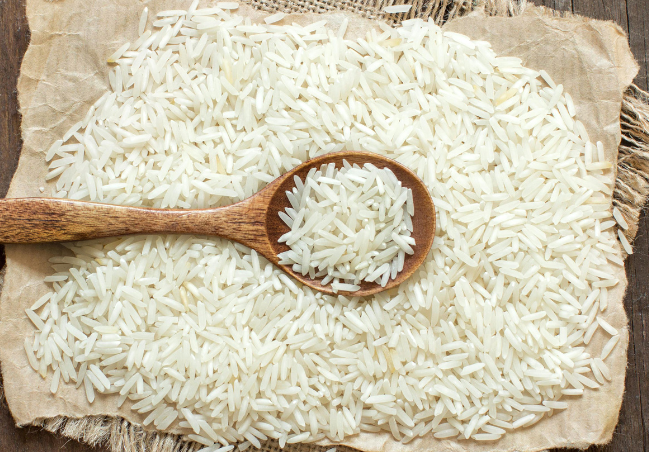Commercial Cultivation of HT Basmati Rice (GS Paper 3, Economy)

Why in News?
- The Indian government has recently approved the commercial cultivation of two non-transgenic herbicide-tolerant (HT) basmati rice varieties: Pusa Basmati 1979 and Pusa Basmati 1985.
- This decision marks a significant development in rice cultivation in India, driven by the Indian Council of Agricultural Research (ICAR). The aim is to promote more sustainable paddy farming practices that conserve water and lower carbon emissions.
About the New HT Rice Varieties
Non-Transgenic Nature:
Definition of Transgenic and Non-Transgenic:
- Transgenic Organisms: These are genetically modified organisms (GMOs) where foreign genes from other species are introduced into the genome.
- Non-Transgenic Organisms: These do not involve the insertion of foreign genes but can achieve genetic modifications through other methods like mutation breeding.
- Mutation Breeding: The HT rice varieties are non-transgenic because their herbicide tolerance is achieved through mutation breeding rather than inserting foreign genes. This method involves inducing genetic changes within the existing rice genome.
Key Genetic Feature:
- Mutated ALS Gene: The new rice varieties have a mutated AcetoLactate Synthase (ALS) gene. This genetic alteration allows the rice plants to tolerate the herbicide Imazethapyr without affecting their growth.
- Role of ALS Gene: The ALS gene encodes an enzyme critical for synthesizing amino acids essential for plant growth. Normally, herbicides like Imazethapyr bind to this enzyme, disrupting amino acid production and killing the plant.
- Mutation Effect: In these HT varieties, the mutation in the ALS gene prevents the herbicide from binding to the enzyme, allowing the rice plant to grow while the herbicide controls weeds.
Herbicide Application:
- Imazethapyr Use: The herbicide Imazethapyr is effective against various weeds but does not harm the HT rice plants due to the mutated ALS gene.
- Weed Control: This herbicide targets broadleaf, grassy, and sedge weeds. By making the rice plants tolerant, the herbicide kills the weeds while leaving the crop unharmed.
Benefits of HT Rice Varieties
Agricultural Efficiency:
- Reduced Labor and Water Use: HT rice cultivation reduces the need for traditional practices like nursery preparation, puddling, and transplanting. It also eliminates the need for extensive field flooding.
- Direct Seeding of Rice (DSR): These varieties support DSR, where seeds are directly drilled into the field, leading to more efficient water use and reduced methane emissions. DSR requires only one pre-sowing irrigation, unlike traditional methods which need multiple irrigations.
Environmental Impact:
- Reduced Methane Emissions: Traditional paddy fields are flooded for prolonged periods, producing significant methane, a potent greenhouse gas. DSR and HT rice cultivation reduce this flooding, leading to lower methane emissions.
- Water Conservation: The new cultivation method uses less water compared to conventional methods, addressing water scarcity issues.
Concerns and Challenges
Risk of Super Weeds:
- Resistance Development: Continuous use of the same herbicide can lead to the evolution of "super weeds" resistant to the herbicide. This could necessitate stronger or additional herbicides, potentially creating a cycle of increasing chemical use.
-
Herbicide Residue:
- Food Safety: There are concerns about the accumulation of herbicide residues in the food chain. Despite assurances that the HT rice will be residue-free, ongoing monitoring and validation are essential.
International Trade Implications:
- Global Standards: While Imazethapyr is approved in India, it is banned in the European Union. This discrepancy might affect the international trade of Indian basmati rice, potentially limiting access to some markets.
Long-Term Sustainability:
- Ecological Impact: Increased herbicide use over time could have unforeseen ecological consequences. Continuous assessment of the environmental impact of HT rice cultivation is necessary to ensure its long-term sustainability.
Paddy Transplantation vs Direct Seeding of Rice (DSR)
Paddy Transplantation:
- Process: Involves growing seedlings in a nursery, then transferring them to a puddled field. Fields must be maintained with standing water for the first few weeks and receive regular irrigation.
- Labor and Water Intensity: High labor requirements for transplantation and significant water use for maintaining standing water.
Direct Seeding of Rice (DSR):
- Process: Seeds are directly sown into the field without prior nursery preparation or puddling.
- Efficiency: Requires less water and labor, and reduces the duration of field flooding, contributing to lower methane emissions and less soil disturbance.
Rice Cultivation in India
Climate and Production:
- Requirements: Rice needs high temperatures (above 25°C) and high humidity, with annual rainfall above 100 cm. It is grown extensively in states with favorable climatic conditions, such as West Bengal, Uttar Pradesh, Punjab, Tamil Nadu, Haryana, Andhra Pradesh, Telangana, and Kerala.
- Yield: India is the second-largest rice producer globally and the top exporter of basmati rice, valued for its unique fragrance and taste.
Export:
- Volume and Value: In 2022-23, India exported 4.56 million tonnes of basmati rice worth USD 4.78 billion, underscoring its importance as a major agricultural export.
Conclusion
- The approval of HT basmati rice varieties is a significant advancement in agricultural technology, aiming to improve efficiency and sustainability in rice cultivation.
- While the benefits include reduced labor and water use, lower methane emissions, and support for DSR, concerns about herbicide resistance, residue, and international trade standards need to be carefully addressed.
- Balancing these factors will be crucial for the successful integration of HT rice into India's agricultural landscape.


